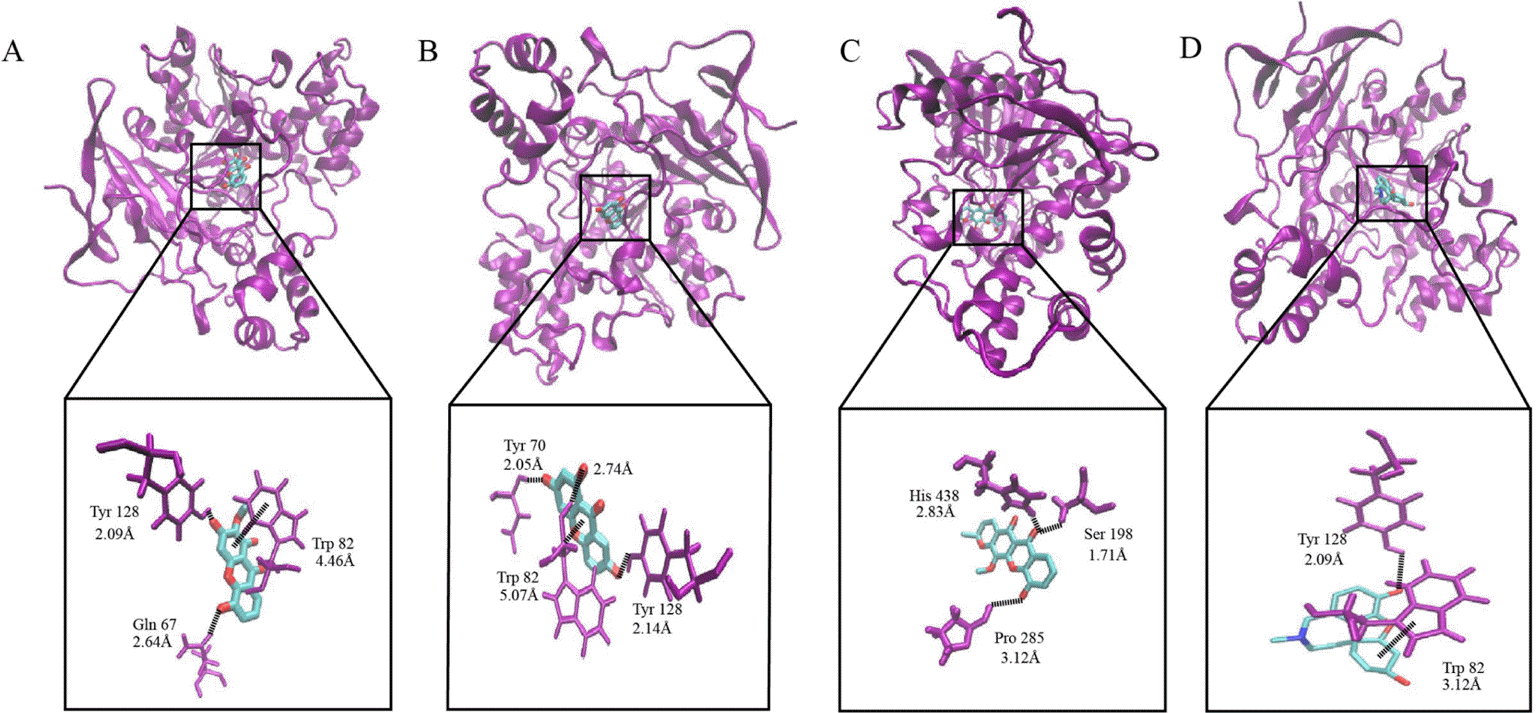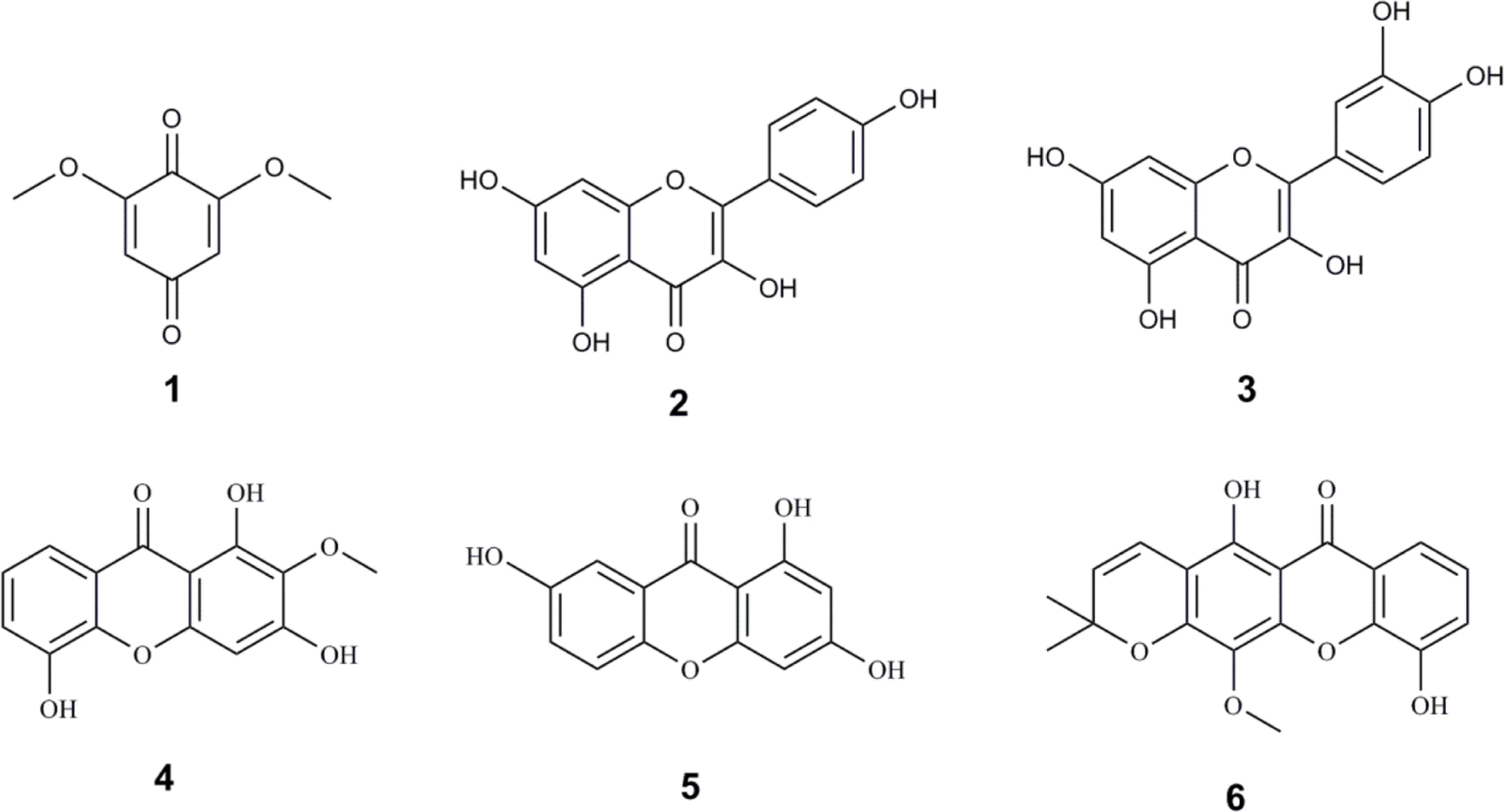Abstract
The present study was undertaken to investigate the isolated compounds from the stem bark of Garcinia atroviridis as potential cholinesterase inhibitors and the ligand-enzyme interactions of selected bioactive compounds in silico. The in vitro cholinesterase results showed that quercetin (3) was the most active AChE inhibitor (12.65 ± 1.57 µg/ml) while garcinexanthone G (6) was the most active BChE inhibitor (18.86 ± 2.41 µg/ ml). It is noteworthy to note that compound 6 was a selective inhibitor with the selectivity index of 11.82. Molecular insight from docking interaction further substantiate that orientation of compound 6 in the catalytic site which enhanced its binding affinity as compared to other xanthones. The nature of protein-ligand interactions of compound 6 is mainly hydrogen bonding, and the hydroxyl group of compound 6 at C-10 is vital in BChE inhibition activity. Therefore, compound 6 is a notable lead for further drug design and development of BChE selective inhibitor.
Go to : 
References
(1). Tarawneh R.., Holtzman D. M.Cold Spring Harb. Perspect. Med. 2012. 2:, a006148.
(2). Prince M.., Comas-Herrera A.., Knapp M.., Guerchet M.., Karagiannidou M.World Alzheimer Report. 2016.
(3). Herrup K.Nat. Neurosci. 2015. 18:794–799.
(4). Aguzzi A.., O'Connor T.Nat. Rev. Drug Discov. 2010. 9:237–248.
(5). Hardy J.., Selkoe D. J.Science. 2002. 297:353–356.
(6). Colovi M. B.., Krsti D. Z.., Lazarevi -Pašti T. D.., Bondži A. có có có có M.., Vasi V. M.Curr. Neuropharmacol. 2013. 11:315–335.
(7). Scarpini E.., Schelterns P.., Feldman H.Lancet Neurol. 2003. 2:539–547.
(8). Darvesh S.., Grantham D. L.., Hopkins D. A. J.Comp. Neurol. 1998. 393:374–390.
(9). Perry E. K.., Perry R. H.., Blessed G.., Tomlinson B. E.Neuropathol. Appl. Neurobiol. 1978. 4:273–277.
(11). Sussman J. L.., Harel M.., Frolow F.., Oefner C.., Goldman A.., Toker L.., Silman I.Science. 1991. 253:872–879.
(12). Greig N. H.., Utsuki T.., Ingram D. K.., Wang Y.., Pepeu G.., Scali C.., Yu Q. S.., Mamczarz J.., Holloway H. W.., Giordano T.., Chen D.., Furukawa K.., Sambamurti K.., Brossi A.., Lahiri D. K. Proc. Natl. Acad. Sci. U. S.A. 2005. 102:17213–17218.
(13). Tan W. N.., Khairuddean M.., Wong K. C.., Khaw K. Y.., Vikneswaran M.Fitoterapia. 2014. 97:261–267.
(14). Tan W. N.., Khairuddean M.., Wong K. C.., Tong W. Y.., Ibrahim D. J.Asian Nat. Prod. Res. 2016. 18:804–811.
(15). Ellman G. L.., Courtney K. D.., Andres V. Jr.., Feather-Stone R. M.Biochem. Pharmacol. 1961. 7:88–95.
(16). Morris G. M.., Goodsell D. S.., Halliday R. S.., Huey R.., Hart W. E.., Belew R. K.., Olson A. J. J.Comput. Chem. 1998. 19:1639–1662.
(17). Carletti E.., Aurbek N.., Gillon E.., Loiodice M.., Nicolet Y.., Fontecilla-Camps J. -C.., Masson P.., Thiermann H.., Nachon F.., Worek F.Biochem. J. 2009. 421:97–106.
(18). Humphrey W.., Dalke A.., Schulten K. J.Mol. Graph. 1996. 14:33–38.
(19). Khaw K. Y.., Choi S. B.., Tan S. C.., Wahab H. A.., Chan K. L.., Murugaiyah V.Phytomedicine. 2014. 21:1303–1309.
(20). Louh G. N.., Lannang A. M.., Mbazoa C. D.., Tangmouo J. G.., Komguem J.., Castilho P.., Ngninzeko F. N.., Qamar N.., Lontsi D.., Choudhary M. I.., Sondengam B. L.Phytochemistry. 2008. 69:1013–1017.
(21). Khan M. T. H.., Orhan I.., Senol F. S.., Kartal M.., Sener B.., Dvorská M.., Smejkal K.., Slapetová T.Chem. Biol. Interact. 2009. 181:383–389.
(22). Sriraksa N.., Wattanathorn J.., Muchimapura S.., Tiamkao S.., Brown K.., Chaisiwamongkol K.Evid. Based Complement. Alternat. Med. 2012. 2012:823206.
Go to : 
 | Fig. 2.Binding interactions of compounds 4 – 6 and galanthamine with the amino acids of butyrylcholinesterase. A-D represents compounds 4 – 6 and galanthamine, respectively. |
Table 1.
Cholinesterase inhibitory activities of compounds 1 – 6 from the stem bark of G. atroviridis
Table 2.
Binding interactions of compounds 4 – 6 with BChE




 PDF
PDF ePub
ePub Citation
Citation Print
Print



 XML Download
XML Download